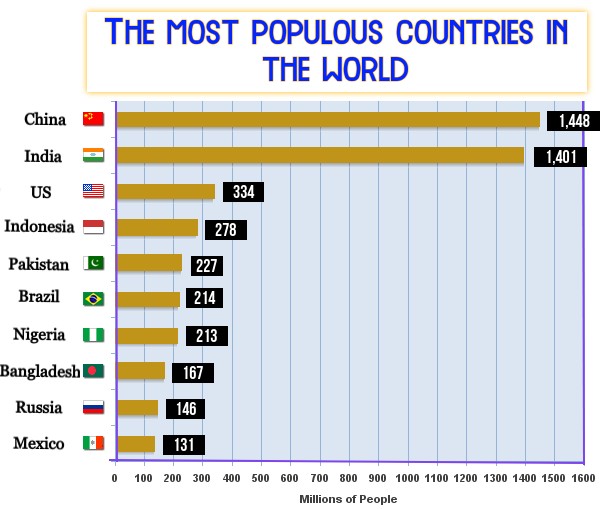The global landscape is marked by a mosaic of nations, each with its unique culture, history, and people. Among these, some countries stand out for their sheer population size, playing a significant role in shaping the world’s demographic and socio-economic dynamics. In this exploration, we delve into the 10 most populated countries in the world, highlighting the factors that contribute to their demographic prominence.
The 10 Most Populated Countries in the World
The estimated world population is 8,045,311,447 (at mid-year, according to U.N. estimates). Here are the Introducing top ten of the world’s most populated countries:
1. China:
With a population exceeding 1.4 billion, China claims the top spot as the world’s most populous country. This East Asian giant, known for its rich history and rapid economic growth, hosts a diverse population spread across vast urban centers and rural landscapes. Key contributors to China’s population size include its historical legacy, cultural values, and governmental policies.
2. India:
Following closely, India ranks as the second most populous country globally, with over 1.3 billion people. This South Asian nation is characterized by its cultural diversity, historical significance, and a population that spans bustling cities, rural villages, and diverse landscapes. Factors such as high birth rates, cultural practices, and economic opportunities contribute to India’s demographic weight.
3. United States:
The United States, a North American powerhouse, is the third most populous country with over 330 million people. A melting pot of cultures and a land of opportunities, the U.S. attracts immigrants from around the world. Its population growth is influenced by factors such as immigration, a diverse birth rate, and social and economic mobility.
4. Indonesia:
In Southeast Asia, Indonesia takes the fourth spot with a population exceeding 270 million. An archipelago of diverse islands, Indonesia is home to a vibrant mix of ethnicities, languages, and cultures. High birth rates, cultural values, and economic developments contribute to the country’s demographic significance.
5. Pakistan:
With a population surpassing 225 million, Pakistan is the fifth most populous country globally. Located in South Asia, it shares cultural and historical ties with neighboring India. Factors such as a high birth rate, cultural norms, and urbanization contribute to the country’s demographic landscape.
6. Brazil:
As the largest country in South America, Brazil is the sixth most populous globally, with over 213 million people. Known for its diverse ecosystems, vibrant culture, and economic prominence, Brazil’s population growth is influenced by factors such as fertility rates, urbanization, and regional disparities.
7. Nigeria:
In West Africa, Nigeria stands as the seventh most populous country, with over 211 million people. A nation with a rich cultural heritage and economic potential, Nigeria’s population growth is propelled by high birth rates, urbanization, and regional dynamics.
8. Bangladesh:
Nestled in South Asia, Bangladesh is the eighth most populous country, with a population exceeding 166 million. Despite being one of the world’s most densely populated nations, Bangladesh continues to experience population growth influenced by factors such as fertility rates, economic conditions, and societal norms.
9. Russia:
As the largest country geographically, Russia is the ninth most populous, with over 145 million people. Its expansive landmass spans Europe and Asia, hosting a diverse population. Population growth in Russia is affected by factors such as birth rates, immigration patterns, and socio-economic conditions.
10. Mexico:
Completing the list, Mexico ranks as the tenth most populous country, with over 126 million people. A North American nation with a rich cultural heritage, Mexico’s population growth is shaped by factors such as fertility rates, migration, and economic opportunities.
Factors Influencing Population Dynamics:
- Birth Rates: High birth rates contribute significantly to the population growth of these countries. Cultural values, societal norms, and access to family planning services influence birth rates.
- Urbanization: The shift from rural to urban living is a common trend in many populous countries. Cities attract people with economic opportunities, leading to concentrated population centers.
- Economic Opportunities: Countries with robust economies often attract a large population, driven by job opportunities, industrialization, and urban development.
- Cultural Practices: Cultural values and practices, including preferences for larger families, influence population size in many regions.
- Government Policies: Government initiatives, such as family planning programs or pro-natalist policies, play a crucial role in shaping population dynamics.
- Immigration: Countries with significant immigration contribute to their population growth. Economic opportunities, political stability, and quality of life often attract migrants.
Challenges and Opportunities:
While a large population can be a source of economic vitality, it also poses challenges such as pressure on resources, infrastructure, and social services. Managing population growth responsibly becomes crucial for sustainable development.
Understanding the factors that contribute to the demographic landscape of these populous countries is essential for policymakers, researchers, and global leaders. As the world continues to evolve, the population dynamics of these countries will play a central role in shaping global trends and influencing international relations.

